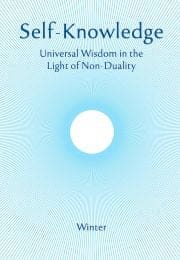Four Qualifications for the Path to the Goal of Liberation
Goal-setting is a widely-recommended strategy for effective working and achieving success and happiness. Having a goal means:
- being clear about what one wants;
- not being put off by distractions and set-backs;
- developing relevant skills and personal qualities;
- keeping it in mind as the top priority.
Goal-setting is no doubt an effective way of getting things done. Whether it leads to lasting happiness or not depends on the chosen objective.
The importance of having a goal is not an exclusively modern or secular idea. The Crest Jewel of Discerning Wisdom (Viveka Chudamani), and Direct Experience of Reality (Aparokshanubhuti) are two classic texts on non-duality, composed centuries ago, which both begin by saying that four ‘qualifications’ or ‘forms of readiness’ are necessary for a seeker of inner illumination, and all four relate to the highest goal of life. They are:
- discernment of what is lasting and valuable (in Sanskrit, viveka);
- relative indifference to everything else (vairagya);
- inner resources beginning with mental calm (shama);
- burning desire for liberation from suffering (mumukshuta).
Both these texts were once believed to have been written by Shri Shankara, the great philosopher-sage who formulated the non-dual teachings as we know them. They are now generally considered to be restatements of Shankara’s teachings by followers who had reached the summit of wisdom, which means these writings are of proven practical value.
The four qualities have to be present to some degree before we even start on the path. According to Direct Experience they arise from the lessons learned while endeavouring to live an honest and productive life. At a certain stage we come to feel that nothing in the world is going to make us entirely happy and only something that is not affected by the passing of time could bring lasting fulfilment and inner peace. This is the first stirring of discernment, viveka. With it comes a growing indifference to lesser matters, and thus vairagya appears. We come to value inner equilibrium, and practise maintaining it: this is the beginning of shama and the rest. Eventually the desire for liberation from bondage becomes our central focus, and so mumukshuta is established in our being.
We may have heard of the non-dual teachings before, at a time when we were fully engaged in exploring what the world has to offer and our own capacities. But then the message would have made little impression on us, being seemingly irrelevant, and perhaps implausible.
Our judgment changes when we begin to sense the uncertain nature and value of the phenomenal world. We then see the relevance of the teaching that there is a lasting reality behind the changing appearances, and that this reality is in fact our own true nature. At this point we will be willing to give credence, at least tentatively, to the testimony of those who have known this mind-transcending Reality in direct experience, and who indicate a way by which we can pursue the great discovery for ourselves. So this readiness to hear, and to countenance, the essential principle of non-duality, arises after life-experience has endowed us with some viveka, vairagya, shama and mumukshuta, which is why they are called the necessary ‘qualifications’ for the path.
Let us consider each of them further, beginning with viveka.
Discernment (viveka) between the eternal (nitya) and the passing (anitya), is the conviction that Brahman is absolutely real (satyam), the changing world (jagat) is uncertain (mithya). [Crest Jewel, 20]
Self (atman) is eternal (nitya), what is perceived is the opposite. This conviction is called viveka. [Direct Experience, 5]
According to both texts, viveka is the ability to distinguish between what is nitya and a-nitya. These words mean permanent, unchanging, and the opposite.
It is said in the non-dual philosophy that only what is unchanging is absolutely real. There are subtle metaphysical arguments in support of this, and to consider them may be helpful for us sometimes in our study and inquiry. What is clear is that anything impermanent cannot bring us enduring satisfaction and inner security. This conclusion does not rely on complex reasoning: it is certain that if we depend on something that will change, we are vulnerable to disappointment and anxiety. So the essential distinction to be made, viveka, is between what is lasting and what is transient.
Then comes the question, what, if anything, is unchanging? To discover the answer is the ultimate goal of our search. In the classic teaching texts we are given the answer provisionally: only Brahman does not change. Everything in the world changes; everything with form will change. Even ‘God’ conceived as the creator and sustainer of the world is associated with change. Only the absolute, transcendental Brahman does not change. And thus comes in the Crest Jewel a famous distillation of the non-dual teachings: Brahma satyam jagan mithya: Brahman (alone is) Real, (the) changing world (is) contrary. The word mithya, translated here as contrary or uncertain, has no single English equivalent. It means that the reality-status of the phenomenal world cannot be stated definitively, it is indeterminate. To be convinced of this is true viveka.
Beginning at this philosophical apex, the principle of viveka is to be applied throughout all our practical dealings with the world: in what we buy, read, the relationships we develop, and much else. Living wisely, all our judgments are influenced by how far the matter in question may help or hinder us in approaching the ultimate goal of liberation, which means the discovery of the Real, what does not change.
As we saw, vairagya, the second of the four qualifications for the path, may be translated as equanimity or passionlessness, although it indicates a detachment from and control of our emotions, rather than a lack of feeling. It is said:
True vairagya is to look on all objects of passing enjoyment, from the heavenly realm to the things of this world, with the same indifference as one looks on effluvia. (Direct Experience, 4)
Vairagya is the wish to give up all transient enjoyments obtained through the senses out of all changing phenomena from the body to the heavenly realm. (Crest Jewel, 21)
Vairagya is defined forcibly here to impress its significance on our minds, but this is not a philosophy of escapism, nor a rejection of what is truly good and beautiful in experience. It does not prohibit the legitimate enjoyment of, for example, nourishing food that helps us stay energetic and healthy, nor of the beauty of nature. These verses emphasise that if we rely on what is passing, we shall inevitably be let down, and this applies equally to conceptions of ‘heaven’ imagined as idealised versions of this world. Of real value is what guides and helps us to attain the security and bliss that time cannot take away: anything entirely dissociated from this contains a hidden sting and cost, and this is the ‘enjoyment’ we long to be free of.
Vairagya is best understood and practised as the corollary of viveka: the natural disinterest in what cannot bring lasting satisfaction and security. This is balanced vairagya. And the best way to cultivate vairagya is by sustaining and deepening our viveka. Otherwise, we are not practising detachment but actively rejecting what is transient, which is another way of giving it exaggerated significance.
This brings us to the third of the qualifications, resourcefulness. The Sanskrit name, shat-sampad, literally means six treasures or possessions and this inner resourcefulness manifests in six distinguishable qualities. They are: shama, calm, tranquillity; dama, self-control; uparati, withdrawal, recollection; titiksha, patience, endurance; shraddha, constancy in our convictions; samadhana, one pointedness, focus, concentration.
What combines these six elements and makes them essential is that they are all expressions of the capacity to sustain our viveka and vairagya. Viveka has an intrinsic appeal, it is the awareness that inner peace and bliss are attainable, and vairagya is the mood that naturally follows. But distractions and obstacles arise.
Among the most common of these difficulties is simply rapidly wandering thoughts. The solution is shama, tranquilisation of the mind, like the taming of a wild horse.
Many distractions come through the senses, energised by our instincts. And so we need to apply dama, control of the senses, by being selective about what we look at, listen to, and touch.
Even when our eyes and ears are turned in a chosen direction, we may continue to give undue attention to the reports of the senses. We are easily distracted by new impressions. What is required is recollectedness, uparati, withdrawal to our inner centre, where we can rightly gauge the significance of sense-experiences, and not be instinctively enslaved to their demands for attention.
Inevitably, life sometimes presents us with sorrow and suffering. Often these experiences are magnified by our own reactions, and it is our reactions which determine whether the difficulties throw us off course. Common, but unhelpful, reactions are: pointless complaining, engaging all the powers of our imagination in worry, and sometimes a desire for revenge or retribution. What helps here is titiksha, which the Crest Jewel describes as patient endurance without unnecessary lament, anxiety or vengefulness.
Shraddha is often translated as ‘faith’, but a more accurate definition would be strength in our convictions. Shraddha does not mean trying to believe something without good reason. Thoughts and moods arise, prompting us to ask again whether there is a Reality behind the appearances, if it is possible to know the higher Self, and whether it is worth the effort or if it would be better to settle for more immediate consolations. Shraddha is the ability to recognise these for what they are, just stray thoughts and moods, and to bring back to mind the convictions we have established through our deliberate reflections and meditations: that there cannot be more than one reality, and that must be the essence of our own personality, and that nothing could be so liberating and fulfilling as Self-realisation. Shraddha is the opposite of naivety and irrationality. It is founded on viveka and we draw upon it so that random thoughts and fluctuating moods cannot do lasting harm.
In order to achieve anything or find happiness anywhere, we need focus and concentration, that is to ‘be here, now’ (and on task!). We are easily undermined by irrelevant thoughts, frequently based on fear and hope. It is well-known that the mind can only think of one thing at a time, and to consciously make use of this fact is samadhana, which means to curb the tendency of the mind to pass swiftly from one object to another, and be one-pointed, by remembering our objective.
Clearly, the six-treasures, shatsampad, are closely related, and each of them largely implies the others. Whenever distractions and difficulties present themselves, as they do all the time, we will find that one of these six great inner resources is what is needed to restore our balance and well-being.
Viveka, vairagya and shatsampad together might lead to a noble stoicism, but not yet to the summit of Self-realization. For that is needed also the fourth of the qualifications, mumukshuta: desire for liberation.
The hope to be free of suffering and be admitted to ‘heaven’, is a common feature of human psychology. We might dismiss this as mere wishful thinking and perhaps superstitious. Still, it is a powerful force which may be secretly at work in the depths of our own mind, particularly at times of acute anxiety. Mumukshuta rightly understood can harness the urgency engendered by the limited life-time remaining to us, without imagining an other-worldly paradise, or hoping that a divine force will bestow special favour on us.
Regarding mumukshuta, the Crest Jewel says that we are in bondage because we are identified with the ego and the body: we believe ourselves to be defined by the limitations of the mind and body and that we shall perish when they do. In truth, this is an illusion: the mind and body are better understood as our instruments, our real self is more subtle, inward and universal. Mumukshuta is the will to be free of this bondage, which is ultimately illusory, through direct knowledge of our true Self: the eternal, perfect, unbound Reality in all. It is based on the clear reasoning of the non-dual philosophy, and does not appeal to any dominion outside our own being.
Mumukshuta is a desire, unlike viveka, vairagya and the six treasures, and thus it has motive power. But it is a unique desire: it implies no lack or imperfection in our nature, it is only the longing that an illusion whic hides our true nature should be removed.
What may obscure the desire for liberation is other desires. So in relation to them we use our resourcefulness to sustain vairagya. As we saw, vairagya follows from viveka, and our discernment of what is unchanging will in turn heighten as the clarity of vairagya and the drive of mumukshuta infuse our inner world. Then we are able to receive the essential non-dual message about the identity of human consciousness and Brahman. Thus equipped, we are launched on the journey of vichara, inner exploration, which can lead us from theoretical understanding to direct experience.
P.H.


